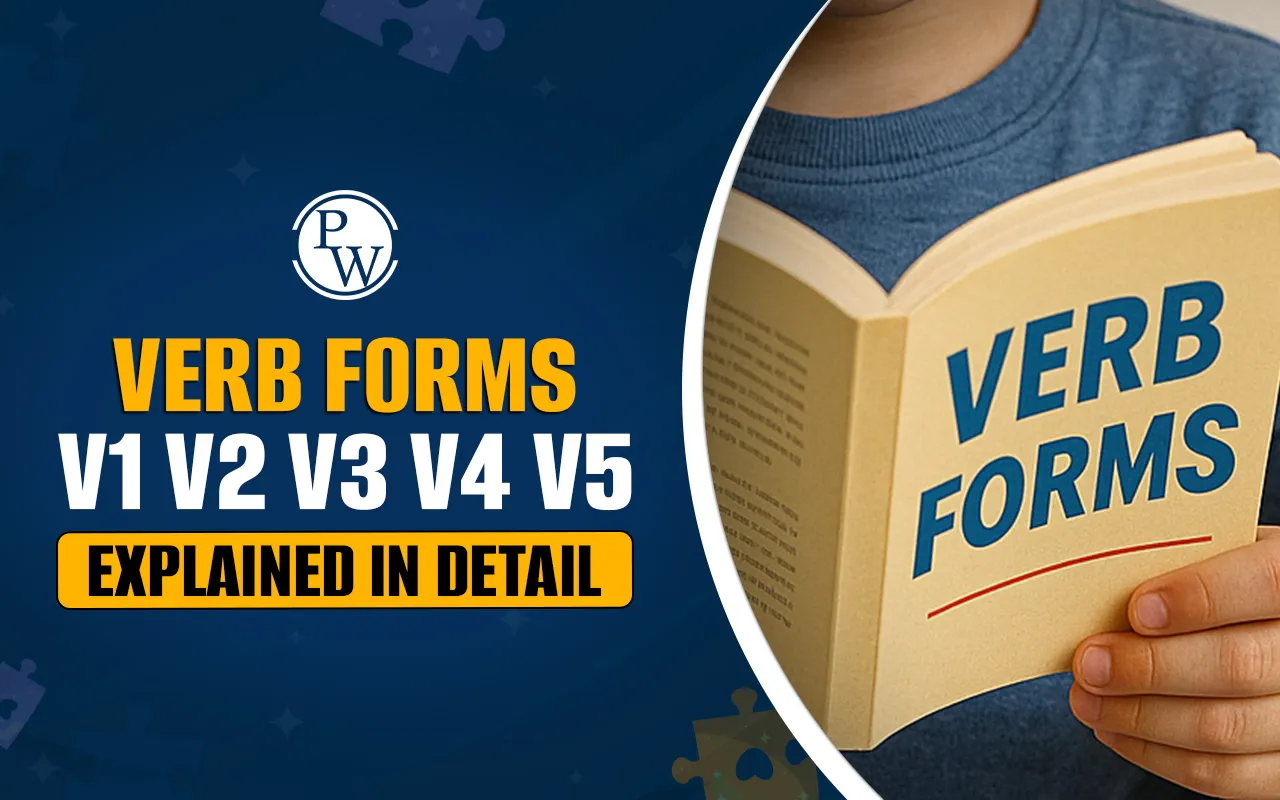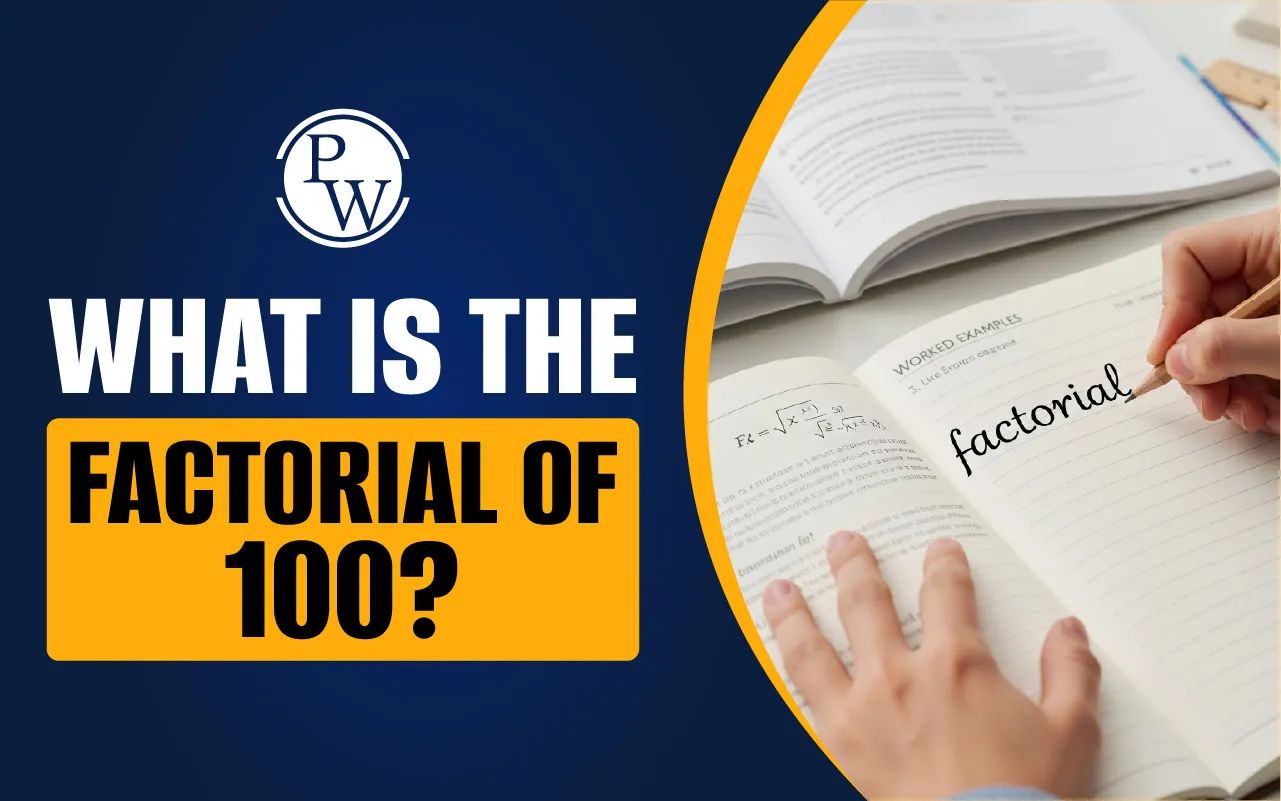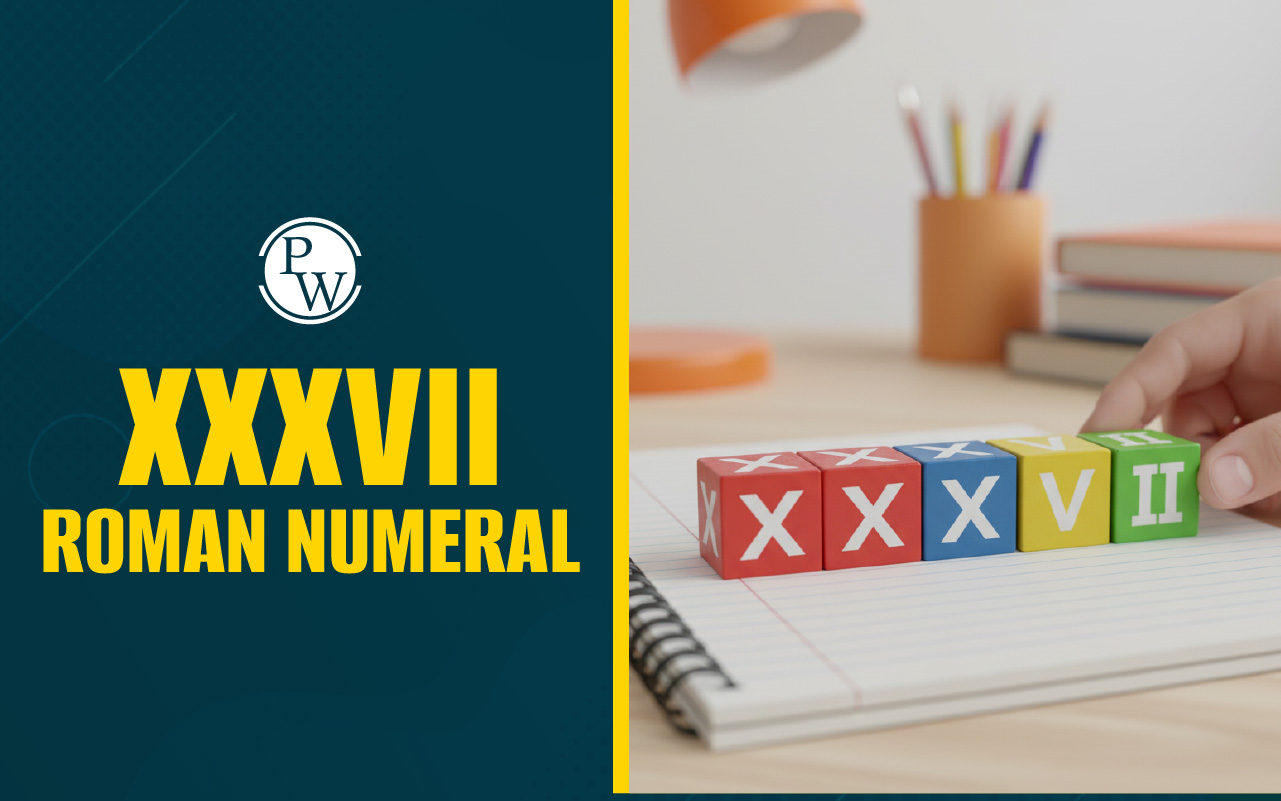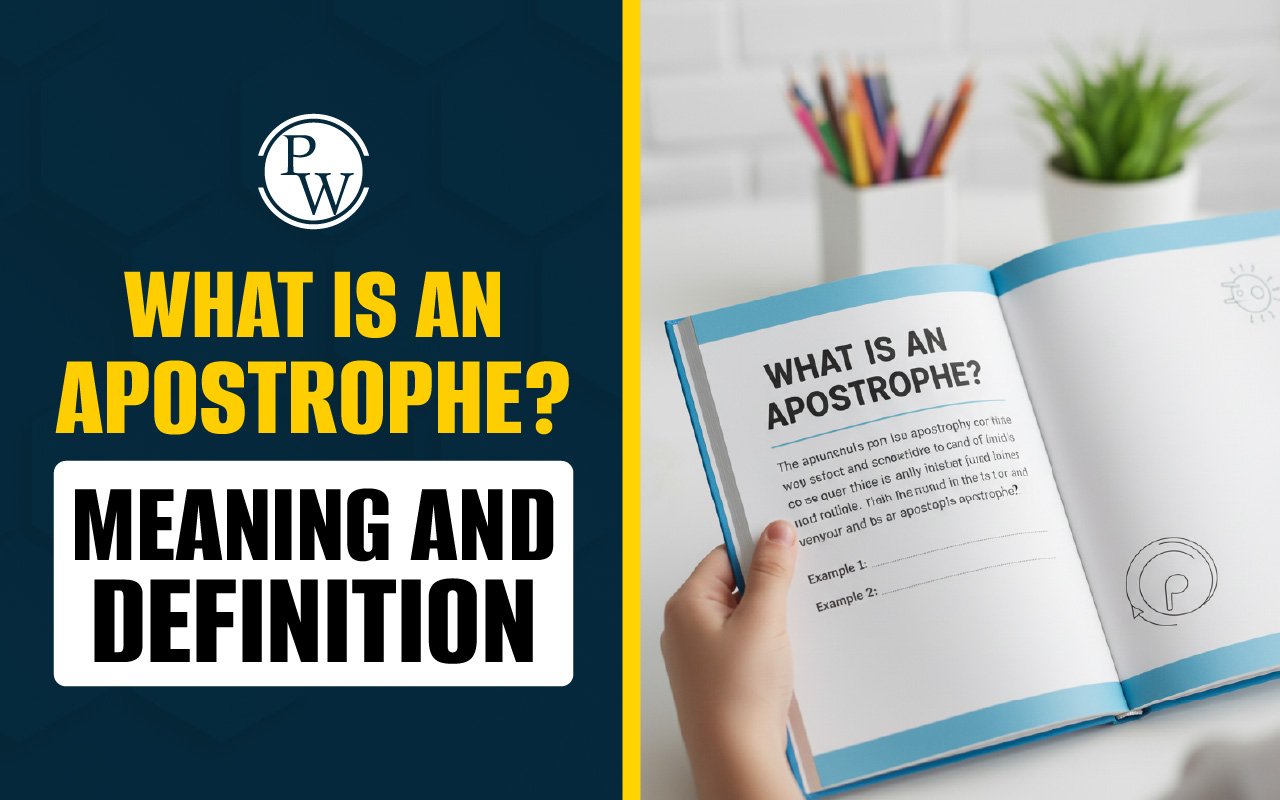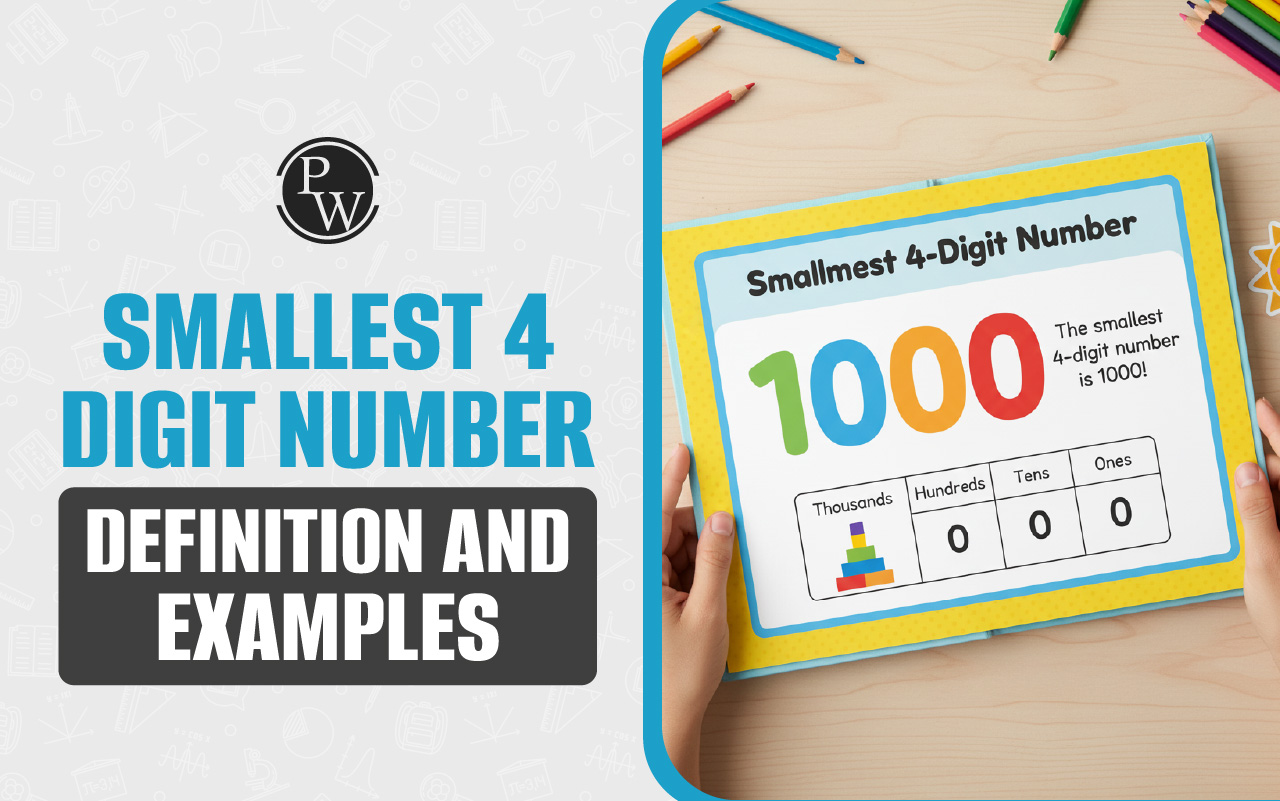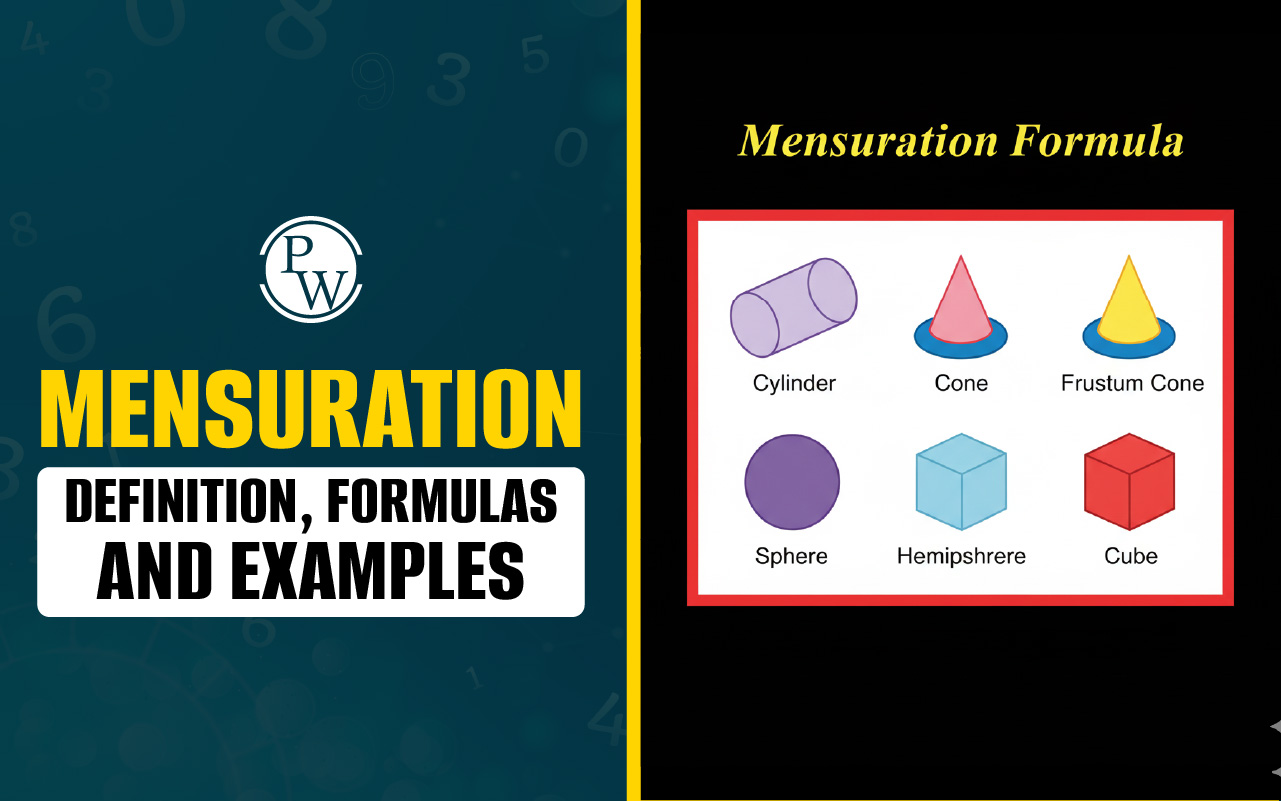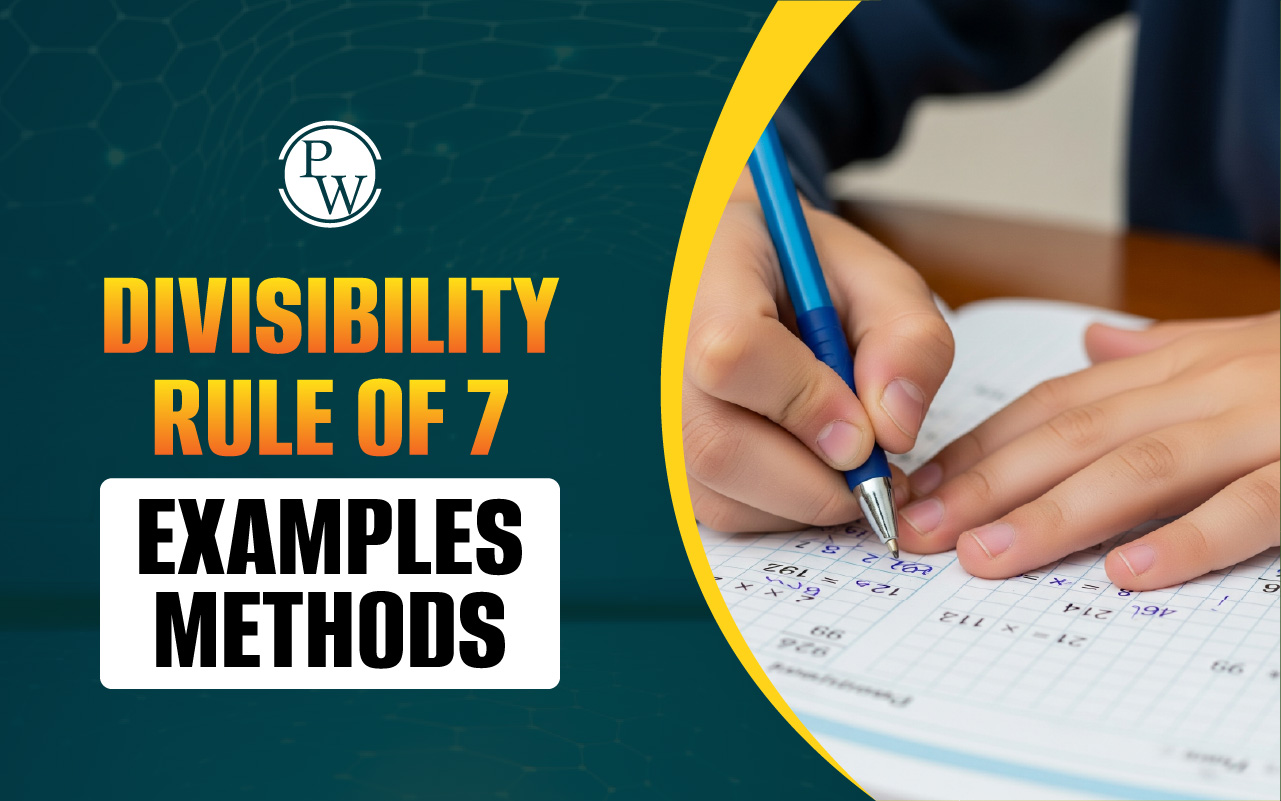
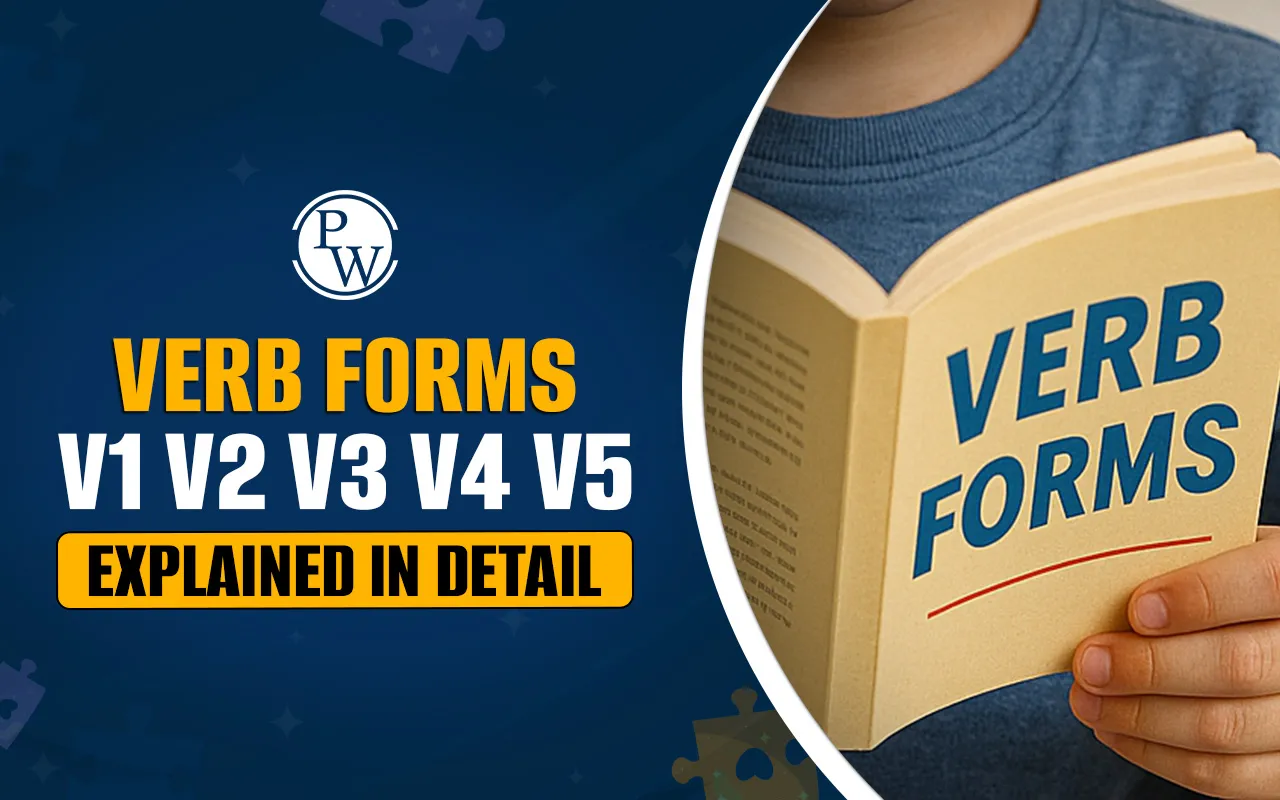
Verb Forms V1 V2 V3 V4 V5: In English grammar, verbs are action words, as they tell us what someone or something is doing. But verbs change their form based on time, subject, or the way we want to say something. These different forms are known as verb forms V1 V2 V3 V4 V5, and each one has its own role in making correct sentences.
When students learn all five verb forms, it becomes easier to choose the correct form of the verb while writing or speaking. These verb forms also help students understand tenses and sentence structure better. Keep reading to learn about all 5 forms of verbs with simple examples.
Read More: Types of Sentences with Examples
What are Verb Forms?
Verb forms are the different ways a verb can change to match the subject, tense, or meaning in a sentence. The 5 forms of verbs are V1, V2, V3, V4, and V5. These forms help us talk about an action that is happening now, happened in the past, or will happen later.
The first form is called the root form or base form. It is the original verb, like play, go, read, or cook. This is the form we find in a dictionary. It does not have any extra endings like -s, -es, or -ing.
Verb Forms V1 V2 V3 V4 V5 Overview
The five verb forms V1 V2 V3 V4 V5, help us use verbs correctly in different sentences. Each form has a special use to show when an action happens or how it happens.
-
V1 is the base form or root form. It is used for simple present tense and is the original form of the verb, like go or write.
-
V2 shows past actions. It is used for the simple past tense, for example, went or wrote.
-
V3 is the past participle. It is used in perfect tenses and passive voice, like gone or written.
-
V4 is the present participle or gerund. It ends with -ing and is used for continuous actions, such as going or writing.
-
V5 is the third-person singular form used in the present tense with he, she, or it. It often ends with -s or -es; for example, goes or writes.
Learning all verb forms V1 V2 V3, V4, and V5—helps us pick the correct form of the verb to make correct sentences in English. Let's now discuss 5 forms of verbs one by one to better understand them.
Read More: Idioms and Phrases in English
Verb Form V1 with Meaning and Example
Verb Form V1 is the base form of a verb. It is the simplest form of verb without any changes or endings and is the same word we find in the dictionary. Verb form V1 is also called the infinitive form (without “to”).
-
We use V1 to talk about habits, facts, or general truths. It is also used to make the present simple tense for most subjects except the third person singular (he, she, it).
-
For example: Children eat their lunch at noon. Here, eat is the correct form of the verb, showing a regular action that happens every day.
Read More: Subject and Predicate
Verb Form V2 with Meaning and Example
Verb Form V2 is the past tense form of a verb. It is also called the simple past form. We use V2 to talk about actions or events that happened and finished in the past.
-
For regular verbs, we add -ed to make the V2 form. But irregular verbs have special past forms that students need to remember.
-
For example: Yesterday, children played football. Here, played is the V2 form of the verb play, showing the action happened in the past.
Verb Form V3 with Meaning and Example
Verb Form V3 is the past participle form of a verb. It is used with helping verbs like have, has, or had to talk about actions that are completed. It is also used in passive sentences.
-
For regular verbs, V3 is made by adding -ed. Irregular verbs have special past participle forms to learn.
-
For example, I have eaten lunch already. Here, eaten is the V3 form of eat, showing the action is finished.
Verb Form V4 with Meaning and Example
Verb Form V4 is called the present participle or gerund. It ends with -ing and is used to show actions that are happening now or are continuing.
-
Verb form V4 also acts like an adjective sometimes.
-
For example, I am eating lunch right now. In this example, eating is the V4 form of eat, showing the action is happening now.
Verb Form V5 with Meaning and Example
Verb Form V5 is the third-person singular present tense form. It is used with he, she, or it to talk about habits or facts in the present.
-
Usually, we add -s or -es to the base verb to make V5.
-
For example, She walks to school every day. In this, walks is the V5 form of walk, used for third-person singular.
Read More: Sentence Structure
Verb Forms V1 V2 V3 V4 V5 100 Words List
Knowing the verb V1 V2 V3 forms along with V4 and V5 helps understand how actions happen in different times and situations. To practice, it is vital to see examples. Therefore, here is a list of verb forms V1 V2 V3 V4 V5 100 words to make it easy for students to learn and remember the correct form of the verb for different sentences.
|
Examples of Verb Forms V1 V2 V3 V4 V5 100 Words |
||||
|
V1 (Base) |
V2 (Past) |
V3 (Past Participle) |
V4 (Present Participle) |
V5 (3rd Person Singular) |
|
accept |
accepted |
accepted |
accepting |
accepts |
|
add |
added |
added |
adding |
adds |
|
agree |
agreed |
agreed |
agreeing |
agrees |
|
allow |
allowed |
allowed |
allowing |
allows |
|
answer |
answered |
answered |
answering |
answers |
|
ask |
asked |
asked |
asking |
asks |
|
be |
was/were |
been |
being |
is |
|
become |
became |
become |
becoming |
becomes |
|
begin |
began |
begun |
beginning |
begins |
|
believe |
believed |
believed |
believing |
believes |
|
break |
broke |
broken |
breaking |
breaks |
|
bring |
brought |
brought |
bringing |
brings |
|
build |
built |
built |
building |
builds |
|
buy |
bought |
bought |
buying |
buys |
|
call |
called |
called |
calling |
calls |
|
choose |
chose |
chosen |
choosing |
chooses |
|
catch |
caught |
caught |
catching |
catches |
|
change |
changed |
changed |
changing |
changes |
|
clean |
cleaned |
cleaned |
cleaning |
cleans |
|
climb |
climbed |
climbed |
climbing |
climbs |
|
close |
closed |
closed |
closing |
closes |
|
come |
came |
come |
coming |
comes |
|
cook |
cooked |
cooked |
cooking |
cooks |
|
copy |
copied |
copied |
copying |
copies |
|
cut |
cut |
cut |
cutting |
cuts |
|
dance |
danced |
danced |
dancing |
dances |
|
do |
did |
done |
doing |
does |
|
draw |
drew |
drawn |
drawing |
draws |
|
drink |
drank |
drunk |
drinking |
drinks |
|
drive |
drove |
driven |
driving |
drives |
|
eat |
ate |
eaten |
eating |
eats |
|
explain |
explained |
explained |
explaining |
explains |
|
fall |
fell |
fallen |
falling |
falls |
|
feel |
felt |
felt |
feeling |
feels |
|
find |
found |
found |
finding |
finds |
|
finish |
finished |
finished |
finishing |
finishes |
|
fly |
flew |
flown |
flying |
flies |
|
follow |
followed |
followed |
following |
follows |
|
forget |
forgot |
forgotten |
forgetting |
forgets |
|
get |
got |
gotten/got |
getting |
gets |
|
give |
gave |
given |
giving |
gives |
|
go |
went |
gone |
going |
goes |
|
grow |
grew |
grown |
growing |
grows |
|
guess |
guessed |
guessed |
guessing |
guesses |
|
have |
had |
had |
having |
has |
|
hear |
heard |
heard |
hearing |
hears |
|
help |
helped |
helped |
helping |
helps |
|
hold |
held |
held |
holding |
holds |
|
hope |
hoped |
hoped |
hoping |
hopes |
|
hurt |
hurt |
hurt |
hurting |
hurts |
|
keep |
kept |
kept |
keeping |
keeps |
|
know |
knew |
known |
knowing |
knows |
|
laugh |
laughed |
laughed |
laughing |
laughs |
|
learn |
learned/learnt |
learned/learnt |
learning |
learns |
|
leave |
left |
left |
leaving |
leaves |
|
let |
let |
let |
letting |
lets |
|
like |
liked |
liked |
liking |
likes |
|
listen |
listened |
listened |
listening |
listens |
|
live |
lived |
lived |
living |
lives |
|
look |
looked |
looked |
looking |
looks |
|
lose |
lost |
lost |
losing |
loses |
|
love |
loved |
loved |
loving |
loves |
|
make |
made |
made |
making |
makes |
|
hope |
hoped |
hoped |
hoping |
hopes |
|
mean |
meant |
meant |
meaning |
means |
|
meet |
met |
met |
meeting |
meets |
|
move |
moved |
moved |
moving |
moves |
|
need |
needed |
needed |
needing |
needs |
|
open |
opened |
opened |
opening |
opens |
|
order |
ordered |
ordered |
ordering |
orders |
|
pay |
paid |
paid |
paying |
pays |
|
play |
played |
played |
playing |
plays |
|
put |
put |
put |
putting |
puts |
|
read |
read |
read |
reading |
reads |
|
ride |
rode |
ridden |
riding |
rides |
|
ring |
rang |
rung |
ringing |
rings |
|
rise |
rose |
risen |
rising |
rises |
|
run |
ran |
run |
running |
runs |
|
say |
said |
said |
saying |
says |
|
see |
saw |
seen |
seeing |
sees |
|
sell |
sold |
sold |
selling |
sells |
|
send |
sent |
sent |
sending |
sends |
|
set |
set |
set |
setting |
sets |
|
show |
showed |
shown |
showing |
shows |
|
shut |
shut |
shut |
shutting |
shuts |
|
sing |
sang |
sung |
singing |
sings |
|
sit |
sat |
sat |
sitting |
sits |
|
sleep |
slept |
slept |
sleeping |
sleeps |
|
speak |
spoke |
spoken |
speaking |
speaks |
|
spend |
spent |
spent |
spending |
spends |
|
stand |
stood |
stood |
standing |
stands |
|
start |
started |
started |
starting |
starts |
|
stop |
stopped |
stopped |
stopping |
stops |
|
study |
studied |
studied |
studying |
studies |
|
succeed |
succeeded |
succeeded |
succeeding |
succeeds |
|
take |
took |
taken |
taking |
takes |
|
talk |
talked |
talked |
talking |
talks |
|
teach |
taught |
taught |
teaching |
teaches |
|
tell |
told |
told |
telling |
tells |
|
think |
thought |
thought |
thinking |
thinks |
|
try |
tried |
tried |
trying |
tries |
|
turn |
turned |
turned |
turning |
turns |
|
understand |
understood |
understood |
understanding |
understands |
|
use |
used |
used |
using |
uses |
|
wait |
waited |
waited |
waiting |
waits |
|
walk |
walked |
walked |
walking |
walks |
|
want |
wanted |
wanted |
wanting |
wants |
|
watch |
watched |
watched |
watching |
watches |
|
win |
won |
won |
winning |
wins |
|
work |
worked |
worked |
working |
works |
|
write |
wrote |
written |
writing |
writes |
Read More: Material Noun
Verb With No Change in Forms
Some verbs in English are very easy to remember because their verb forms V1 V2 V3 are exactly the same. These verbs do not change even when we talk about past actions or use them in perfect tenses.
Even when used in V4 (present participle) and V5 (third person singular), the base verb remains the same — we just add -ing or -s when needed. Learning these verbs helps us use the correct form of the verb without confusion. Here are some examples of verb forms that stay the same in V1 V2 V3 forms:
|
Verb With No Change in Forms |
||||
|
V1 (Base) |
V2 (Past) |
V3 (Past Participle) |
V4 (Present Participle) |
V5 (3rd Person Singular) |
|
cut |
cut |
cut |
cutting |
cuts |
|
put |
put |
put |
putting |
puts |
|
quit |
quit |
quit |
quitting |
quits |
|
hurt |
hurt |
hurt |
hurting |
hurts |
|
upset |
upset |
upset |
upsetting |
upsets |
|
spread |
spread |
spread |
spreading |
spreads |
|
set |
set |
set |
setting |
sets |
|
reset |
reset |
reset |
resetting |
resets |
|
shut |
shut |
shut |
shutting |
shuts |
|
wet |
wet |
wet |
wetting |
wets |
Read More: Adjectives
Examples of All 5 Forms of Verbs Used in Sentences
Learning through examples is the best way to understand the 5 forms of verbs fully. The verb forms V1 V2 V3 V4 V5 are used in different ways to show time, subject, and action in a sentence. Here are some simple examples of how each form is used while speaking or writing in English.
1. Base Form (V1): Present Simple Tense
-
Students play cricket after school.
-
I wash my hands before eating.
-
They read books in the library.
-
We like to eat all kinds of fruits.
-
Children sing rhymes in class.
2. Past Simple Form (V2)
-
She watched a movie last night.
-
I lost my pencil in the classroom.
-
We bought mangoes from the market.
-
The dog ran away quickly.
-
He spoke in front of the whole class.
3. Past Participle Form (V3)
-
The students have completed their homework.
-
I have seen that movie before.
-
She has written a beautiful poem.
-
We had eaten lunch by 2 p.m.
-
He has taken all the books home.
4. Present Participle Form (V4)
-
The baby is crying loudly.
-
They are playing football in the field.
-
I am drawing scenery.
-
She is talking on the phone.
-
We are preparing for the test.
5. Third Person Singular Present (V5)
-
He drinks milk every morning.
-
She writes neatly in her notebook.
-
The sun rises in the east.
-
My mother cooks tasty food.
-
The bird flies high in the sky.
Read More: Synonyms
Verb Forms V1 V2 V3 V4 V5 Practice Questions With Answers
Q. Fill in the blanks with the correct form of the verb given in brackets:
-
Riya always ____ her homework on time. (do)
-
Yesterday, we ____ a fun movie. (watch)
-
He has ____ all the chocolates. (eat)
-
They are ____ for the exam. (prepare)
-
My sister ____ very sweet songs. (sing)
-
We ____ to the zoo last weekend. (go)
-
She has ____ a letter to her friend. (write)
-
Look! The baby is ____ . (sleep)
-
The dog always ____ loudly at strangers. (bark)
-
I ____ a new story yesterday. (begin)
Answers:
-
Does
-
Watched
-
Eaten
-
Preparing
-
Sings
-
Went
-
Written
-
Sleeping
-
Barks
-
Began
Help Your Child Shine in Grammar with CuriousJr English Online Classes
Is your child struggling with English grammar rules like verb forms or often using the wrong form of verbs while writing and speaking? This is a common challenge for many children, but the right support at the right time can be a game changer. That’s exactly what English online classes for kids by CuriousJr are designed for.
-
These classes not only help with school English studies but also focus on building a strong foundation in grammar, vocabulary, writing, pronunciation, and fluency.
-
Each student gets a dedicated teacher for one-on-one support, so doubts are cleared quickly and learning becomes more effective.
-
With regular practice, personal attention, and structured lessons, your child will grow more confident in English and start performing better in school.
Book a demo class today and enhance your child's grammar learning with CuriousJr.
Verb Forms FAQs
What do verb forms V1 V2 V3 V4 V5 mean?
Why is learning all 5 forms of verb important?
When to use verb forms V1 V2 V3 in a sentence?
How to find the correct form of the verb to use in a sentence?

